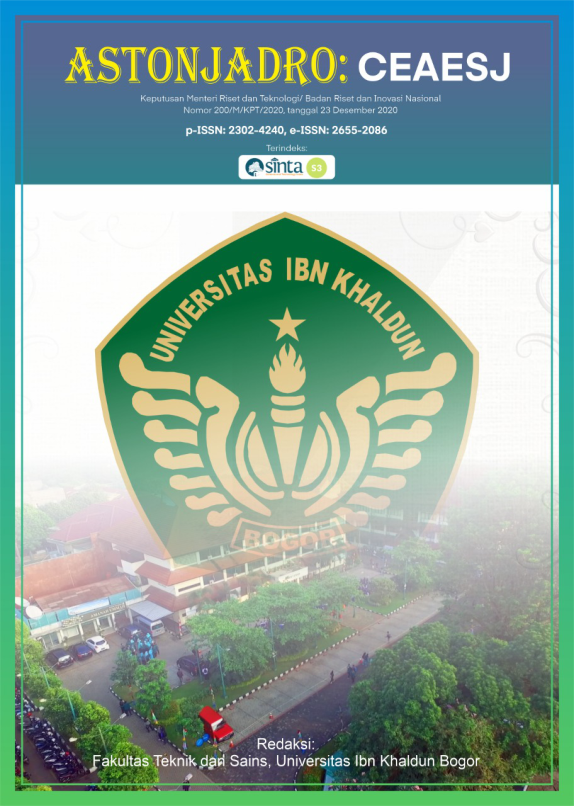COCONUT LEAF WASTE PROCESSING WITH BIODRYING PROCESS AS RAW MATERIAL FOR BIOMASS PELLETS IN WASTE TO ENERGY
DOI:
https://doi.org/10.32832/astonjadro.v11i1.5853Keywords:
biodrying, coconut leaves, waste, caloric value.Abstract
Coconut leaf waste is a type of waste that contains a good enough calorific value to be used as raw material for biomass pellets. The minimum standard calorific value of biomass in Indonesia according to SNI 8675:2018 is 16.05 MJ/kg. Meanwhile, based on the research results, the calorific value of coconut leaf waste has a value of 13.34 MJ/kg. The way that can be applied to increase the calorific value is by biodrying. This study aimed to determine the effectiveness of the biodrying process in processing coconut leaf waste. This study use bioactivators in the form of tempe yeast, baker's yeast, and tapai yeast. Mass loss and moisture reduction can be achieved, respectively, 8.25-17.62% and 62.4-65.6%. The calorific value can reach the minimum standard after seven days of processing with a value of 17,995-18,623 MJ/kg.
References
Adani, F., Baido, D., Calcaterra, E., & Genevini, P. (2002). The influence of biomass temperature on biostabilization–biodrying of municipal solid waste. Bioresource Technology, 83(3), 173–179. https://doi.org/10.1016/S0960-8524(01)00231-0
Colomer-Mendoza, F. J., Herrera-Prats, L., Robles-Martínez, F., Gallardo-Izquierdo, A., & Piña-Guzmán, A. B. (2013). Effect of airflow on biodrying of gardening wastes in reactors. Journal of Environmental Sciences, 25(5), 865–872. https://doi.org/10.1016/S1001-0742(12)60123-5
Debertoldi, M., Vallini, G., & Pera, A. (1983). The biology of composting: A review. Waste Management & Research, 1(2), 157–176. https://doi.org/10.1016/0734-242X(83)90055-1
Fadlilah, N., & Yudihanto, G. (2013). Pemanfaatan Sampah Makanan Menjadi Bahan Bakar Alternatif dengan Metode Biodrying. Teknik Pomits, 2(2), 289–293. (Indonesian).
Mohammed, M., Ozbay, I., & Durmusoglu, E. (2017). Bio-drying of green waste with high moisture content. Process Safety and Environmental Protection, 111, 420–427. https://doi.org/10.1016/j.psep.2017.08.002
Nguyen, P. H. L., Kuruparan, P., & Visvanathan, C. (2007). Anaerobic digestion of municipal solid waste as a treatment prior to landfill. Bioresource Technology, 98(2), 380–387. https://doi.org/10.1016/J.BIORTECH.2005.12.018
Pestaño, L. D. B., & Jose, W. I. (2016). Production of Solid Fuel by Torrefaction Using Coconut Leaves As Renewable Biomass. International Journal of Renewable Energy Development, 5(3), 187–197. https://doi.org/10.14710/ijred.5.3.187-197
Qonitan, F. D., Suryawan, I. W. K., & Rahman, A. (2021). Overview of Municipal Solid Waste Generation and Energy Utilization Potential in Major Cities of Indonesia. Journal of Physics: Conference Series, 1858(1). https://doi.org/10.1088/1742-6596/1858/1/012064
Sarwono, A., Septiariva, I. Y., Qonitan, F. D., Zahra, N. L., Sari, N. K., Fauziah, E. N., Ummatin, K. K., Amoa, Q., Faria, N., Wei, L. J., &
Suryawan, I. W. K. (2021). Municipal Solid Waste Treatment for Energy Recovery Through Thermal Waste-To-Energy in Depok City, Indonesia. Journal of Advanced Research in Fluid Mechanics and Thermal Sciences, 85.
Septiariva, I. V. A. Y., & Suryawan, I. W. K. (2021). Development of water quality index (WQI) and hydrogen sulfide (H2S) for assessment around suwung landfill, Bali Island. Journal of Sustainability Science and Management, 16(4), 137–148.
Sofiyah, E. S., & Suryawan, I. W. K. (2021). Cultivation of Spirulina platensis and Nannochloropsis oculata for nutrient removal from municipal wastewater. Rekayasa, 14(1), 93–97. https://doi.org/10.21107/rekayasa.v14i1.8882
Sugni, M., Calcaterra, E., & Adani, F. (2005). Biostabilization–biodrying of municipal solid waste by inverting air-flow. Bioresource Technology, 96(12), 1331–1337. https://doi.org/10.1016/J.BIORTECH.2004.11.016
Suryawan, I. W. K., Wijaya, I. M. W., Sari, N. K., & Yenis, I. (2021). Potential of Energy Municipal Solid Waste ( MSW ) to Become Refuse Derived Fuel ( RDF ) in Bali Province , Indonesia. Jurnal Bahan Alam Terbarukan, 10(200).
Widyarsana, I. M. W., Damanhuri, E., Ulhusna, N., & Agustina, E. (2020). A Preliminary Study : Identification of Stream Waste Quantity and Composition in Bali Province , Indonesia. 5.
Downloads
Published
How to Cite
Issue
Section
License
Copyright (c) 2021 ASTONJADRO: CEAESJ

This work is licensed under a Creative Commons Attribution-ShareAlike 4.0 International License.
Paper submitted to ASTONJADRO is the sole property of the Astonjadro Journal. Unless the author withdraws the paper because he does not want to be published in this journal. The publication rights are in the journal Astonjadro.ASTONJADRO
LICENSE
This work is licensed under a Creative Commons Attribution-ShareAlike 4.0 International License.
Based on a work at http://ejournal.uika-bogor.ac.id/index.php/ASTONJADRO













